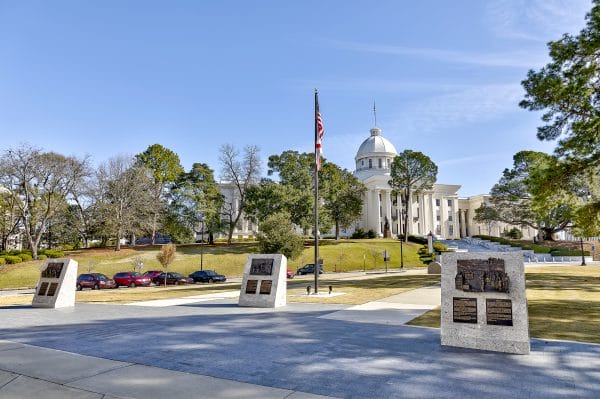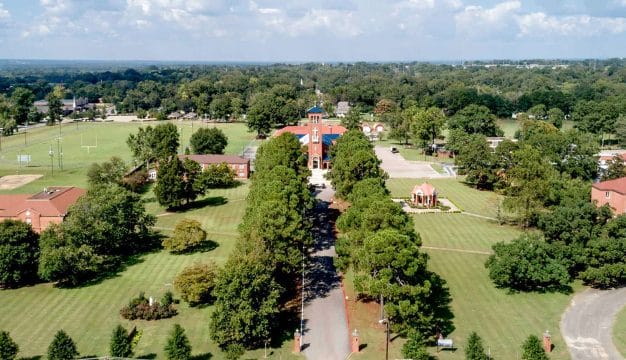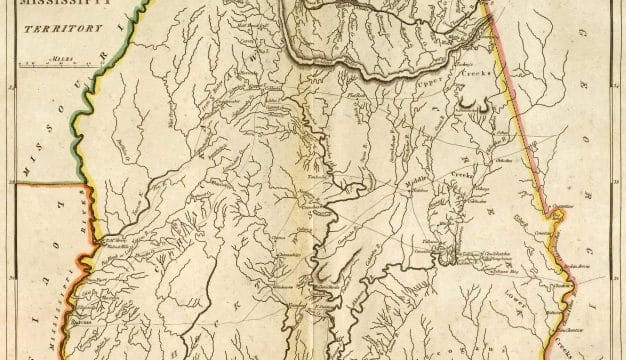Alabama Bicentennial Park
The Alabama Bicentennial Park in Montgomery, Montgomery County, is a commemorative park that celebrates Alabama's 200-year history from its prehistoric beginnings into the present day. It consists of 16 granite monuments with bronze reliefs depicting various scenes of Alabama history as well as more than 30 bronze plaques that detail important periods in the state's history. The park was dedicated by Gov. Kay Ivey on December 14, 2019, at the concluding celebration of the three-year celebration of the state's bicentennial that began in 2017 with a March 3 announcement on the steps of the Capitol and a May 5 gala in Mobile, Mobile County.
 Mound Builders Monument
The Alabama State Council on the Arts (ASCA) oversaw the project, contracting with Tuscaloosa artist Caleb O'Connor to create the bronze reliefs, with University of Alabama (UA) art professor Craig Wedderspoon overseeing their casting. The bronze plaques were designed by UA art professor Jonathan Cumberland. Alabama Department of Archives and History staff contributed research and text towards the project with the support of the Alabama Historical Commission, the Alabama Department of Finance, and the Alabama Bicentennial Commission, which oversaw and coordinated the numerous events that took place over the three-year celebration.
Mound Builders Monument
The Alabama State Council on the Arts (ASCA) oversaw the project, contracting with Tuscaloosa artist Caleb O'Connor to create the bronze reliefs, with University of Alabama (UA) art professor Craig Wedderspoon overseeing their casting. The bronze plaques were designed by UA art professor Jonathan Cumberland. Alabama Department of Archives and History staff contributed research and text towards the project with the support of the Alabama Historical Commission, the Alabama Department of Finance, and the Alabama Bicentennial Commission, which oversaw and coordinated the numerous events that took place over the three-year celebration.
 Space Race Monument
The Alabama Bicentennial Park was developed out of an idea proposed by a Leadership Montgomery class in the 1990s. By 2017, plans were lain for the park, and the state committed up to $2 million to build the park, with the unveiling planned for the 200th anniversary of Alabama's founding on December 14, 2019. The park was constructed in the greenspaces in front of the Office of the Attorney General and the Lurleen Wallace Office Building. Funding for the project came from the Capitol Grounds and Maintenance Fund.
Space Race Monument
The Alabama Bicentennial Park was developed out of an idea proposed by a Leadership Montgomery class in the 1990s. By 2017, plans were lain for the park, and the state committed up to $2 million to build the park, with the unveiling planned for the 200th anniversary of Alabama's founding on December 14, 2019. The park was constructed in the greenspaces in front of the Office of the Attorney General and the Lurleen Wallace Office Building. Funding for the project came from the Capitol Grounds and Maintenance Fund.
 Prehistoric Life Monument
The Alabama Bicentennial Park dedication was part of the conclusion of the three-year Alabama Bicentennial celebration. The Bicentennial Festival included a parade, exhibitions, performances, children's games, arts and crafts, musical performances, reenactments, and open houses throughout the Capitol area and downtown Montgomery. Those events were followed by the Alabama Bicentennial Concert featuring Alabamians Taylor Hicks, Jett Williams, Eddie Floyd, Jimmy Hall, Martha Reeves, and more, backed by the Muscle Shoals All-Stars. The celebration ended with the "Sculpting A State" digital light show sponsored by the Poarch Band of Creek Indians and projected on Alabama's Attorney General building.
Prehistoric Life Monument
The Alabama Bicentennial Park dedication was part of the conclusion of the three-year Alabama Bicentennial celebration. The Bicentennial Festival included a parade, exhibitions, performances, children's games, arts and crafts, musical performances, reenactments, and open houses throughout the Capitol area and downtown Montgomery. Those events were followed by the Alabama Bicentennial Concert featuring Alabamians Taylor Hicks, Jett Williams, Eddie Floyd, Jimmy Hall, Martha Reeves, and more, backed by the Muscle Shoals All-Stars. The celebration ended with the "Sculpting A State" digital light show sponsored by the Poarch Band of Creek Indians and projected on Alabama's Attorney General building.
The Alabama Bicentennial Park traces the state's history from its prehistoric beginnings into the present day through 16 Alabama granite monuments, each of which bears bronze relief sculptures as well as one to three bronze plaques with text explaining events and pivotal eras in Alabama history.
The monuments are arranged in a large semicircle with eight monuments on each side of Dexter Avenue chronologically from left to right:
- The Ancient Sea Monument features a bronze relief depicting the area's early prehistoric sea life, including the state fossil Basilosaurus, with a plaque describing the prehistoric environment of the area.
- The Alabama's First Peoples and Creek Country Monument includes a bronze relief of the state's earliest inhabitants, including mound builders and Creek Indians along with a plaque describing their subsequent growth as the largest indigenous group in Alabama.
- The Resistance and War Monument includes a bronze relief of the Battle of Horseshoe Bend and two plaques describing the arrival of white settlers and the resultant conflicts with native inhabitants.
- The Alabama Territory and Path to Statehood Monument includes a bronze relief of early pioneers in the area with two plaques describing the creation of the Alabama Territory in 1817 and its eventual establishment as a state in 1819.
- The Cotton State and Slavery Monument includes a bronze relief depicting scenes of chattel slavery with two plaques explaining the growth of cotton production in the state and the state's resultant dependence on the institution of slavery.
- The Secession & Confederacy and Civil War Monument includes a bronze relief of the Battle of Mobile Bay and two plaques describing Alabama's secession and participation in the American Civil War.
- The Emancipation and Reconstruction Monument includes a bronze relief depicting the confirmation of John H. Rapier as voting registrar in April 1867 and the first statewide election to include African Americans. Rapier was the father of James T. Rapier, who was one of three African Americans from Alabama elected to the U.S. Congress during Reconstruction. In addition, two plaques describe the effect of emancipation and the period of Reconstruction in Alabama.
- The Industrialization and Iron Boom Monument includes a bronze relief sculpture of workers at the Sloss Furnace Company in Birmingham, Jefferson County, with two plaques describing the state's rapid industrialization in the late nineteenth century and the growth of the iron industry into the twentieth century.
- The Populism and 1901 Constitution Monument includes a bronze relief of the 1901 Constitutional Convention with social reformer Frances Griffin, who argued unsuccessfully for women's suffrage along with two plaques plotting the growth of Populism in the state in the early twentieth century and the passage of the 1901 Constitution, which instead disenfranchised African Americans and many poor whites.
- The Rural Life and Agriculture Economy Monument includes a bronze relief sculpture showing banker Horatio M. Sessions and farmer Charles W. Baston inspecting the first peanut crop in Coffee County in 1915 with corresponding plaques describing the transition of Alabama's economy away from cotton to peanuts after cotton crops were decimated by the boll weevil beginning in the early twentieth century.
- The Great Depression and New Deal Monument includes a bronze relief depicting linemen bringing electricity to rural Marshall County in 1939 with two plaques describing the effect of the Great Depression and the modernization of Alabama brought about by the New Deal in Alabama.
- The World War II and Defense Economy Monument includes a bronze relief depicting the construction of the tanker SS Tule Canyon in Mobile during World War II and two plaques describing Alabama's role in World War II and its growing defense industry during the war.
- The Segregation and Civil Rights Monument includes a bronze relief sculpture of the attack on civil rights marchers in Selma, Dallas County, on "Bloody Sunday" in 1965 with two plaques describing the intense racial segregation and resultant civil rights movement in the state through the 1960s.
- The Made in Alabama and Space Race Monument includes a bronze statue of a Saturn V rocket in Huntsville, Madison County, in 1965 and an adjoining plaque describing the Marshall Space Flight Center's role in the "Space Race" of the 1960s.
- The Globalization and 21st-Century Economy Monument includes a bronze relief depicting the use of robotics in Alabama industry with two plaques describing the state's place in the global economy and its growth in the technology sector.
- The Alabama's Third Century and Alabama Voices Monument includes a bronze relief of the International Space Station and looks ahead towards the state's future in its third century of existence. The Voices plaque recounts the last stanza of educator Julia Strudwick Tutwiler's poem "Alabama," which became the state song in 1931.






